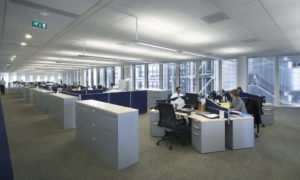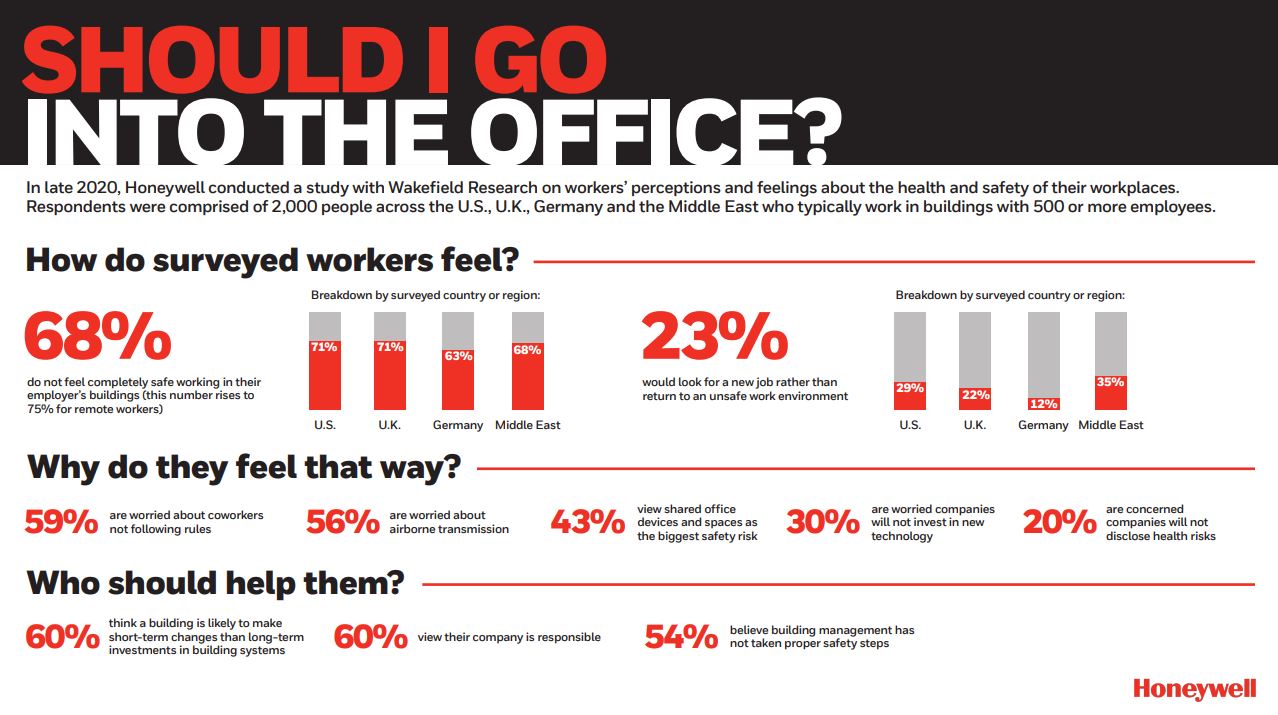Honeywell survey also reveals that 65% of UK workers have not received any safety training from management.
 Software and technologies firm, Honeywell, has released the results of a comprehensive study on workers’ perceptions and feelings on the health and safety of their workplace. The study, carried out by Wakefield Research, polled 500 workers that typically work in buildings with 500 or more employees across the United Kingdom and was part of a global study of 2,000 workers across four markets.
Software and technologies firm, Honeywell, has released the results of a comprehensive study on workers’ perceptions and feelings on the health and safety of their workplace. The study, carried out by Wakefield Research, polled 500 workers that typically work in buildings with 500 or more employees across the United Kingdom and was part of a global study of 2,000 workers across four markets.
The findings show that 71% of the UK workforce does not feel completely safe working in their employer’s buildings. This number is even higher for remote workers (78%), who are especially sceptical about the safety of work sites. In fact, almost a quarter of remote workers globally (23%) would rather look for a new job than return to a site that did not implement necessary safety measures, (22% in the UK). Furthermore, only 35% of workers in the UK have received safety training from building management, compared to 41% globally.
“Workers are keenly attuned to the steps employers are taking to make their workspaces safer and healthier, especially when it comes to air quality and adherence to safety guidelines, which wasn’t previously a concern for some people,” said Vimal Kapur, President and Chief Executive Officer of Honeywell Building Technologies.
“Air quality, for example, is not something that will be dismissed once we’re on the other side of the Coronavirus pandemic. It will be essential to the occupant experience, and good air quality will help make workers feel more comfortable as they return back to their offices.”
COVID-19 transmission
The surveyed workers in the UK are equally concerned about COVID-19 transmission through the air (49%) and through contact with a surface (51%). Their level of concern for surface transfer is significantly higher than that of workers globally (44%). In terms of what poses a bigger threat to their safety, 62% point to co-workers not following safety guidelines and 38% note outdated ventilation systems.
Over half (62%) of surveyed UK workers believe that building management is more likely to make short-term changes in response to COVID-19 rather than make long-term investments in building systems needed to keep them safe. Surveyed workers are most worried that building management will not consistently enforce health and safety guidelines (43%), followed by worry that they won’t consistently invest in new technology to make working in-person safer (28%).
“Many facilities have made changes to their procedures but have not invested in the building itself – and their occupants have noticed,” Kapur said. “Workers are going to demand more from buildings in the future, and we’re even seeing with these survey results that creating a healthier and safer environment will be a differentiator for staff retention and recruiting, and it may also impact long-term real estate value.”
To return to work and feel safer, UK surveyed workers view health safety protocols such as social distancing or mandatory masks as most critical (51%), yet only 55% of those working on-site have seen such updates happen. Other top health and safety measures that surveyed workers want include protocols such as temperature checks (45%), enhanced cleaning procedures (41%), touchless door entries (33%), updated air quality systems (28%) and technology for contact tracing (23%).
Highlights by Country
United Kingdom
- Surveyed workers in the UK are equally concerned with transmission of COVID-19 through touching a surface that has the virus (51%) and through the air (49%).
- A higher percentage of UK respondents believe their building management is likely to make short-term changes in response to COVID-19 (62%) versus long-term investments in building systems.
United States
- Nearly two-thirds of U.S. respondents (64%) indicate that co-workers not following safety guidelines pose a bigger threat than outdated ventilation systems (36%).
- Nearly half of U.S. surveyed workers (49%) are concerned about their building management’s ability to consistently enforce health and safety guidelines.
- Health and safety protocols, such as social distancing or mandatory masks, are viewed as the most critical factor for respondents feeling safer in a building (57%) among U.S. workers. Concurrently, U.S. respondents working on-site noted these as the most implemented measures in their workplaces (61%).
Germany
- Germany has the highest number of surveyed workers working in a building full time (66%).
- German respondents viewed updates to air quality systems (37%) as critical to feeling safer in a building as health safety protocols (36%), and it is the country with the lowest percentage of workers whose buildings have implemented health safety protocols (41%).
- Nearly 9 in 10 remote workers in Germany (88%) would return to their on-site job, even if critical measures are not taken.
Middle East
- The Middle East is evenly split when it comes to respondents’ concerns about COVID-19 transmission through the air (50%) versus through contact with a surface (50%).
- Nearly half of workers in the Middle East say their buildings have implemented enhanced cleaning procedures (46%) and 37% say they have implemented touchless door entry.

Click on the image to enlarge.
Methodology
The Honeywell survey was conducted by Wakefield Research among 500 workers in buildings of 500+ workers in the UK, between November 19th and December 1st, 2020, using an email invitation and an online survey. This was part of a global study of 2,000 people that took place in the U.S., U.K., Germany, and the Middle East. Results of any sample are subject to sampling variation.
The magnitude of the variation is measurable and is affected by the number of interviews and the level of the percentages expressing the results. For the interviews conducted in this particular study, the chances are 95 in 100 that a survey result does not vary, plus or minus, by more than 2.0 percentage points from the result that would be obtained if interviews had been conducted with all persons in the universe represented by the sample.
The Safety Conversation Podcast: Listen now!
The Safety Conversation with SHP (previously the Safety and Health Podcast) aims to bring you the latest news, insights and legislation updates in the form of interviews, discussions and panel debates from leading figures within the profession.
Find us on Apple Podcasts, Spotify and Google Podcasts, subscribe and join the conversation today!

 Software and technologies firm, Honeywell, has released the results of a
Software and technologies firm, Honeywell, has released the results of a 

Simple’ssss, that’s because they are not safe…
Sick Building Syndrome was never really resolved and over-time, office environments only a little safer and still sub-optimal for occupational health of their inhabitants, poor lighting, air-conditioning, workstation and display screen ergonomics for accessibility, let alone aesthetics of a battery hen-house with the only thing self-accessible being water and food dispensers.